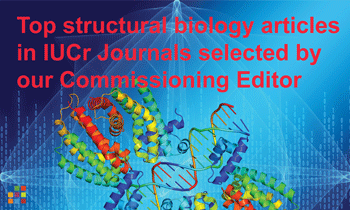issue contents
April 2023 issue

Cover illustration: A selection of structures from the virtual special issue on room temperature structural biology available at https://journals.iucr.org/special_issues/2022/RT.
introduction
Free 

Room-temperature biological crystallography has seen a resurgence in recent years and a collection of articles recently published in IUCrJ, Acta Cryst. D Structural Biology and Acta Cryst. F Structural Biology Communications, have been collected together to produce a virtual special issue at https://journals.iucr.org/special_issues/2022/RT/.
research papers
Open  access
access
 access
accessLikelihood-based rotation, translation and refinement targets have been derived for docking models into cryo-EM reconstructions.
Open  access
access
 access
accessExploiting analogies to crystallographic molecular replacement, a strategy for docking into cryo-EM maps is informed by the calculation of expected log-likelihood-gain scores.
Ambient temperature structures of B. longum phosphoketolase holoenzyme and its complex with a putative inhibitor, phosphoenolpyruvate, demonstrated striking conformational change of the loop at the entrance to the active-site pocket compared with known cryogenic temperature phosphoketolase structures. This structural change highlighted the reaction mechanism and substrate specificity of this enzyme.
Open  access
access
 access
accessFragment derivatives occupy diverse binding sites in two crystal forms of the RNA helicase BRR2 that coincide with predicted, conformation-dependent ligand hot spots.
PDB references: human Brr2 helicase region, complex with C-tail-deleted Jab1 and compound 18, 8bc8; complex with C-tail-deleted Jab1 and compound 24, 8bc9; complex with C-tail-deleted Jab1 and compound 26, 8bca; complex with C-tail-deleted Jab1 and compound 34, 8bcb; complex with C-tail-deleted Jab1 and compound 39, 8bcc; complex with C-tail-deleted Jab1 and compound 50, 8bcd; complex with C-tail-deleted Jab1 and compound 76, 8bce; complex with C-tail-deleted Jab1 and compound 78, 8bcf; complex with C-tail-deleted Jab1 and compound 86, 8bcg; complex with sulfaguanidine, 8bch
L-Proline trans-hydroxylase and its complexes with substrate and product reveal the structural basis of trans–cis proline hydroxylation selectivity. Structure-based sequence alignment and structural comparison suggest signatures for in-line or off-line AKG-binding modes in AKG-dependent hydroxylases and provide deeper insight into AKG-dependent hydroxylation.
PDB references: trans-3/4-proline-hydroxylase H11 with 4-hydroxyproline, 8h81; trans-3/4-proline-hydroxylase H11 apo structure, 8h7t; trans-3/4-proline-hydroxylase H11 with AKG and L-proline, 8h7y; trans-3/4-proline-hydroxylase H11 with AKG, 8h7v; trans-3/4-proline-hydroxylase H11 with 3-hydroxyproline, 8h85
Open  access
access
 access
accessA neural network trained to identify unfavourable fragments and therefore improve protein model building in the Buccaneer software is described.
Open  access
access
 access
accessA new equation for the calculation of substructure-factor amplitudes for substructure detection from a single-wavelength anomalous diffraction experiment produces better results compared with the currently used estimates in test cases.
Open  access
access
 access
accessThe crystal structure of the electron transfer complex between arsenite oxidase (AioAB) from Pseudorhizobium banfieldiae sp. strain NT-26 and its native electron acceptor cytochrome c552 (cytc552) is presented. Cytc552 docks within a cleft at the interface of the AioA and AioB subunits, which allows a close association between redox cofactors.; this close association presumably facilitates fast electron transfer and underpins the ability of this organism to respire in arsenic contaminated environments.
PDB reference: AioAB/cytc552 complex, 8ed4
addenda and errata
Free 

The article by Barbarin-Bocahu & Graille [(2022), Acta Cryst. D78, 517–531] is corrected.

 journal menu
journal menu




























